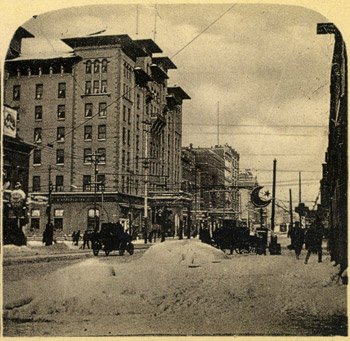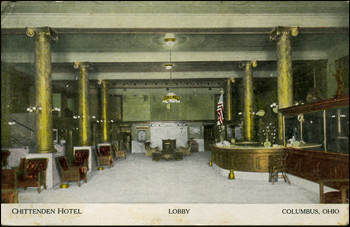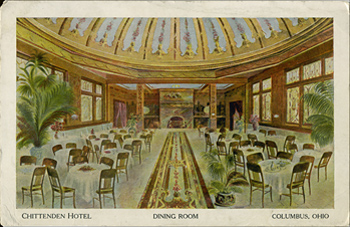
Back in 1873, Chittenden had purchased a tract of land on the northwest corner of N. High and Spring St. It was occupied by an unexceptional commercial building that housed the B&O Railroad’s offices. In 1889, Henry decided to convert the building to a hotel. He added two floors to the building and completely remodeled the rest. The new hotel was appointed with the best décor, fixtures, and furnishings available. Next door, the Moorish façade of the new Park Theater beckoned to visitors. All told, Chittenden spent nearly $400,000 dollars on improving and furnishing the hotel. This at a time when most workers earned less than $10 a week, a loaf of bread cost a penny, and you could get two pounds of bacon or two whole chickens for a quarter. The Chittenden Hotel opened its doors in 1889. The next year, fire broke out and gutted the building and adjacent theater. The buildings were a complete loss. Henry announced he would rebuild and rebuild he did. As soon as the rubble of the first hotel was cleared away, construction of the second Chittenden Hotel began. September 1, 1892, the new hotel opened its doors. In addition to the finest appointments, first class service, and an excellent bill-of-fare, the hotel offered not one but two theaters (The Park on High St. and The Henrietta on Spring) for the amusement of the public. The hotel quickly found favor. Guests and the general public flocked to Henry Chittenden’s showplace. No less a person than Governor William McKinley took a suite of rooms for his official residence. |
|
On the evening of November 24, 1893, a fire broke out in the Henrietta Theater next door to the hotel. The theater was safely evacuated and fire crews arrived. A strong wind fanned the flames and the jumped the alley to the hotel. The guests and staff were successfully evacuated before the hotel turned into a raging inferno. Soon the entire block was ablaze. Firemen fought courageously to halt the spread of the fire and prevent it from burning down the city. By all accounts, it was the greatest fire the city had ever seen. Come morning, the fire was extinguished but the second Chittenden Hotel was nothing but a smoldering ruin. Right: The ruins of the second Chittenden Hotel. Courtesy of the Biography, Travel, and History Division, Columbus Metropolitan Library |
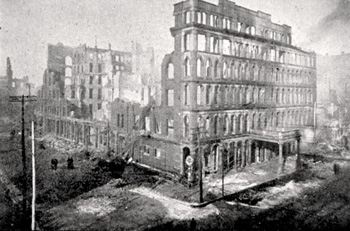 |
Chittenden could have walked away. He was 59 years old, no longer a young man. The hotel had not been insured and Chittenden had seen $300,000 of his own money go up in the blaze. He had a loving family and a lifetime of accomplishments to take pride in. He still had plenty of money. After his hotels had twice been destroyed by fire in three years, there was no reason to try it again. Whether it was stubbornness or stick-to-it-iveness, Chittenden did try it again. He ignored the reasons not to and plowed into the work to build a third Chittenden Hotel. This time, Chittenden did things differently. There would not be a third fire. The new Chittenden Hotel would be as fireproof as possible with 1890s technology. Chittenden decreed “No wooden structural elements.” Instead, the third Chittenden Hotel was built with brick, concrete, stone, tile, and steel. The new hotel exceeded its predecessors in every way. The third Chittenden Hotel wouldn’t just be the last, it would be the best. It would be his monument. |
|
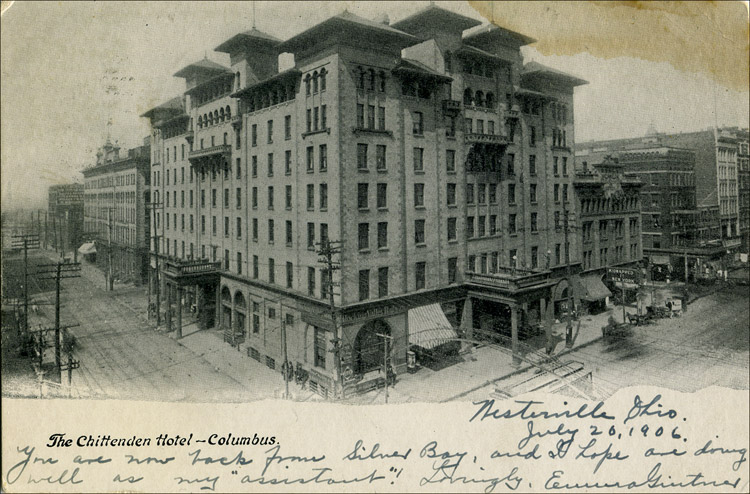 |
|
Busy local architects Frank Packard & Joseph Yost designed the hotel. The team had designed many notable buildings in the city. Orton Hall on the Ohio State campus and the Toledo and Ohio Railroad Station on W. Broad are two surviving Packard & Yost buildings. (For others, see this page.) The eight story hotel (two floors higher than its predecessor) occupied most of the block. The building was crowned with a balconies, open air galleries, and a dozen square towers with overhanging, pyramidal, tiled roofs. Inside, no expense was spared to make the hotel the grandest in Columbus. Fourteen railcars of Vermont marble were required for floors and wainscoting. Nearly $20,000 in Turkish rugs and carpets decorated the floors. Mahogany was imported from Honduras for the paneling in the bar. Marble, fine wood, brass, silver, mirrors, art glass, and elegant furnishings abounded everywhere. Tasteful sculptures and beautiful paintings completed the picture. No area was neglected. The first floor restroom was such a luxury spot that it was written up in the newspapers! Right: Third Chittenden Hotel, view far High St, c. 1900. |
|
The third Chittenden Hotel opened on March 16, 1895 and immediately became the premier hotel in the city. The Chittenden escaped its predecessors’ fiery fate and remained in operation for the next 77 years. Henry Chittenden had about a decade to bask in the glow of his achievement. Around 1905, his health began to fail. He died in 1909 at the age of 75. The Chittenden Hotel became a Columbus institution. It finally closed in 1972 and was demolished the following year. Today, the Ohio Bureau of Workman’s Compensation tower occupies the spot. Grant’s cabin was a tourist draw at the Ohio State Fair for nearly fifty years. The Fair even built a special building in 1896 to cover the cabin and protect it from the elements. By the 1930s, Civil War veterans were either dead or very old and interest in the building was waning. In 1936, it was returned to Point Pleasant, Ohio. Chittenden’s name is preserved on the University District street that used to run pass his streetcar garages and horse barn, the street where his first electric streetcar ran, the street that was the gateway to his big show of 1888. Less prominently, it lives on in the names of the subdivisions built on land he owned along the street. Chittenden Place and the Henry T. Chittenden Addition are bounded by Chittenden to the north, E. 11th to the south, Pearl Alley to the west, and Summit to the east. Right: Views of the lobby and dining room of the third Chittenden Hotel. |
|
 |
|
